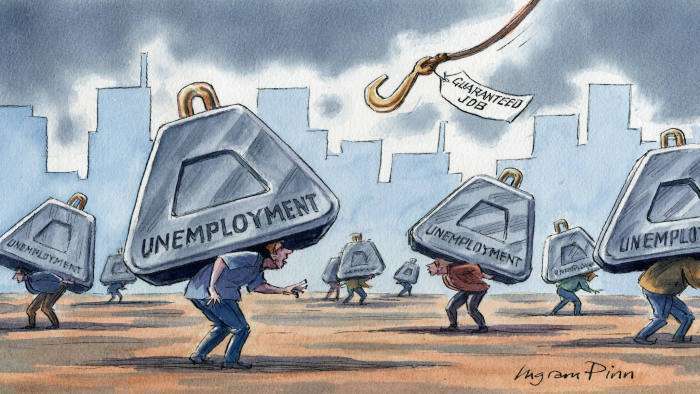The Ticking Time Bomb, Can India Create Enough Jobs For Its Growing Young Population? Even 7% economic growth is Not Enough, Citi. The Youth are struggling as employment growth has Stagnated At 2% for two Decades!

Can India Create Enough Jobs For Its Growing Young Population?
Ask the youth freshly out of college how it is going, and they will tell you it’s tough times – Campus placements are at an all-time low, the fervour, anticipation, and excitement of appearing for an interview and clearing it have now turned into sheer desperation.
For India, since the time of independence it has been struggling with two significant challenges – unemployment and underemployment.
India has predominantly been agricultural, with more workers than needed and not enough money invested in industry, which led to low productivity in factories and farms that depended on the monsoon for good harvests.
Now, in order to measure the job market’s performance, they are two key ways – the Labour Force Participation Rate and the unemployment rate.
The former shows the percentage of people of working age who are either working or looking for work (it gives an idea of the number of people available to work).
The unemployment rate shows the percentage of people who want to work but can’t find a job.
However, these measurements aren’t always precise and can be interpreted differently because of how “working” and “looking for work” are defined.
Thus, this can sometimes hide underemployment, where people have jobs that don’t use their skills fully, making the job situation look better than it is.
 7% Growth Not Enough
7% Growth Not Enough
According to Citigroup Inc., even if India’s economy grows rapidly at 7%, it will still struggle to create enough jobs for its growing population over the next decade.
The country needs to create about 12 million jobs a year to keep up with new workers entering the job market, but at a 7% growth rate, it can only generate 8-9 million jobs a year.
Using a measure that considers someone unemployed if they didn’t do any work in the past week, National Sample Survey (NSS) reports from 1972 to 1987 show the unemployment rate was between 4 and 5 percent, with higher unemployment in cities than in rural areas.
On the other hand, the LFPR stayed pretty stable, with about 58 per cent of people aged 15-59 working or looking for work in 1983 and 1993.
It dropped slightly to 56 per cent between 1999 and 2000 and 50 and 55 per cent between 2019 and 2022.
However, gauging the two reports, the numbers show significant differences.
 From The Past To Present Job Numbers
From The Past To Present Job Numbers
It’s important to note that even though creating jobs has always been a priority for India’s economy, both before and after economic reforms, over 90% of workers are in the informal sector without job security, and less than 20% have regular, salaried jobs.
In 1991, India opened up its economy, allowing some state-owned businesses to be partially privatized and welcoming foreign investment in manufacturing.
This move created some demand for factory workers, but mostly for temporary jobs in special economic zones (SEZs). These zones often had poor working conditions and displaced farmers from their livelihoods for only a small number of jobs.
During this time, mining also provided some informal jobs under difficult conditions and led to disputes over land ownership, many of which are still unresolved. Ancillary industries like transportation also improved from their poor state in the 1980s.
While 1990s industrial growth did not significantly reduce the number of jobs available, it still brought in foreign investment and more capital-intensive production than India had ever seen.
Hence, unemployment rates dropped to below 3% in the late 1990s but increased to 3 and 4% in the early 2000s. However, in 2019, unemployment peaked at 5.8% before dropping to under 4% in 2022.
 The IT Boom And Job Creation
The IT Boom And Job Creation
The service sector boomed in the early 2000s, especially information technology (IT), which led to companies like Infosys, Tata Consultancy Services, and Wipro hiring thousands of engineers to develop software.
The same period also saw the peak of IT-enabled services (ITeS), where many Indians were trained to adopt foreign accents to support customers from developed countries.
Similarly, from 2000 to 2008, there was a high demand for business process outsourcing or BPO services, which led to the rapid growth of Indian “tech hubs” in Bengaluru, Hyderabad, and Pune.
However, this tech boom did not significantly improve job opportunities, even though it helped related industries like logistics, hospitality, construction, and private education grow quickly.
India’s GDP growth, on the other hand, was impressive during this period, especially from 2003 to 2010; it grew above 7.8% in seven of those eight years.
However, labour productivity has risen in proportion to per capita output since 1990, limiting the impact of economic growth on job creation.
To put it in perspective, National Sample Survey (NSS) data over a decade shows that job growth was just above 2% from 2000 to 2012, and this trend of low job creation, around 2%, has continued for most of the past two decades.
Thus, India will struggle to absorb its surplus labour if job growth does not increase significantly, given the current labour force growth rate of 1.69% per year.

So, what is hindering India from making the most of its young population?
It is the problem/challenge of limited job creation!
According to the 2024 International Labour Organization’s (ILO) India Employment Report, the youth (ages 15-29) unemployment rate has been rising over the past several decades-from 5.6% in 2000 to 6.2% in 2012, then nearly tripling to 18% in 2019, before dropping to around 15.1% in 2020.
In 2022, young men’s labour force participation rate (LFPR) was 61.2%, almost three times higher than that of young women, at 21.7%. There was a similar gender gap in both rural and urban areas.
The ILO also recorded that youth unemployment was higher among those with more education, with the highest rates among graduates, and higher among women than men.
Educated, Underemployed, Unemployed And Automation
Another smouldering problem is the unemployment rate of educated people.
In the last two decades, the unemployment rate for educated people has increased, although it dropped sharply between 2019 and 2022.
For example – in 2022, the unemployment rate for youth who had completed secondary education or higher was 18.4%, six times greater than for those with less education.
The rate was even higher for graduates.
Imagine that almost 83% of India’s unemployed are young people, and the share of unemployed youth with secondary or higher education has nearly doubled from 35.2% in 2000 to 65.7% in 2022.
Although the overall unemployment rate appears low and stable, it hides significant underemployment, which means many people want and can work more hours but can’t; underemployment was 8.1% in 2012, rose to 9.1% in 2019 and then fell to 7.5% in 2022.
However, the reduction in job opportunities for those with higher education is also a global issue.
Governments and companies are hiring fewer young people because fewer are needed for administration and governance today compared to a decade ago.
Rising inequality worldwide has reduced demand for goods and services, leading to less production.
Again, increased automation, including artificial intelligence (AI), has made semi-skilled and skilled workers more productive, requiring fewer workers to do the same tasks.
This structural unemployment has had ripple effects throughout the economy, as more skilled workers cannot find jobs matching their education levels and take positions where they are overqualified.
Thus, the process has worsened job prospects for less-educated individuals, who are now seen as less qualified.
Likewise, even the most educated among them may struggle to find jobs in the future, even though young people are best positioned to benefit from new technologies without significant upskilling.
 India’s Unique Problem
India’s Unique Problem
India has also seen jobless growth over the last two decades, contributing to rising inequality.
According to a recent article co-authored by economist Thomas Piketty, the top 1% of India’s population held 22.6% of income and 40.1% of wealth in 2022-23.
Therefore, upskilling may remain out of reach for middle-class job seekers struggling to afford traditional education without redistributing income and wealth.
Job Quality Issues in India
Economists have also pointed out that the quality of jobs being created in India is a significant challenge.
- Official data shows that about 46% of the workforce is still employed in agriculture, even though this sector contributes less than 20% to the country’s GDP.
- Manufacturing jobs accounted for 11.4% of all jobs in 2023, a decrease from 2018, indicating that the sector hasn’t fully recovered since the pandemic as fewer people are now employed in the formal sector than before COVID-19.
- In 2023, only 25.7% of workers were in the formal sector, the lowest level in at least 18 years.
- Only 21% of the workforce, around 122 million people, have jobs that pay a salary or wages, compared to 24% before the pandemic, and more than half of India’s 582 million workers are self-employed.
- The official unemployment rate is 3.2%, but this underestimates the problem.
Most economists prefer data from the Centre for Monitoring Indian Economy (CMIE), which reported an unemployment rate of 9.2% in May, the highest in eight months, while for those aged 20-24, the unemployment rate is over 40%, according to CMIE.
 Threat of Automation And AI
Threat of Automation And AI
Like industrialization, Automation and AI could displace many jobs in various sectors.
- In manufacturing, industries like automobiles and telecom are likely to adopt advanced automation, including 3D printing. This will reduce the need for human workers and lower transportation, logistics, and warehousing costs.
- In services, particularly finance, software development, and IT-enabled services (ITeS), automation could replace many repetitive tasks with machine learning algorithms.
A 2018 report by the International Labour Organization (ILO) identified 640,000 low-skilled service jobs in the IT sector at risk from automation; in contrast, only 160,000 mid- to high-skilled jobs would be created.
New organizations in the “aggregator,” “gig,” or “platform” economy, such as Uber, Ola, Zomato, Swiggy, Dunzo, and Urban Company, have emerged.
A report by the Boston Consulting Group and Dell Foundation in 2021 projected that this sector could create 24 million jobs in the long term. However, depending on the demand for these services, these jobs are often casual and unstable.
 Issues with Gig Economy Jobs
Issues with Gig Economy Jobs
Gig economy jobs are often short-term and contractual, so workers usually don’t get health insurance, retirement plans, paid leave, or unemployment benefits.
The lack of support makes gig workers financially vulnerable, especially during illness or economic downturns.
Moreover, gig workers who earn based on commissions with little or no fixed wages often end up overworked, leading to higher health costs and out-of-pocket expenses.
Automation in Traditional Industries
Traditional industries like textiles, apparel, leather, and footwear are less likely to adopt automation because it is not cost-effective in a country with a surplus of labor like India.
However, agriculture is one traditional sector that has seen some automation, especially in the Global North.
In India, though, most farmers cannot afford the capital investments needed for automation due to small land holdings, low yields, and dependence on rain.
Hence, while agricultural start-ups are introducing more mechanization, widespread use of automation or AI in this sector is unlikely.
 Impact of Climate Change
Impact of Climate Change
Climate change is a significant concern for the future workforce.
A 2018 report from the G20 sustainability group noted that increasing environmental hazards have already reduced human productivity. From 2000 to 2015, hazardous workplace environments caused the loss of 23 million working-life years annually worldwide.
China, Brazil, and India were the most affected G20 countries, losing 8.7, 3.2, and 1.5 working-life years per person per year, respectively, between 2008 and 2015.
Projected temperature increases by 2030 are expected to worsen heat stress, potentially reducing the total number of work hours by 1.9% in G20 countries and by 5.2% in India.
Heat stress is particularly impactful on agricultural workers and those in emerging economies.
Key Points for Future Employment Challenges in India
Considering the difficulties in creating and maintaining jobs in a less promising future, India’s government should remember a few important lessons –
1)Address Deep-rooted Inequality: To boost long-term demand for goods and services, it’s crucial to tackle inequality aggressively.
While having dollar billionaires might seem impressive, a few wealthy individuals won’t create the necessary demand for mass production; hence, unemployment and social disparities will worsen without addressing inequality.
2)Revamp Education and Skills Training: Meeting the needs of a global economy requires not just a few elite institutions but a complete overhaul of the education system.
Currently, there are significant learning gaps between the rich and the poor, and between urban and rural areas; therefore by, ensuring everyone has access to quality education, reskilling, and upskilling is essential.
3)Prepare for Automation: As automation advances and effective demand decreases, there’s a serious risk of creating a “useless class” of people who are structurally unemployable, as historian Yuval Noah Harari puts it.
To prevent this, it’s crucial to discuss creating safety nets, such as universal basic income, to support these individuals and maintain functional markets.
4)Adopt Sustainable Technologies: Countries in the Global South, including India, must rapidly adopt sustainable carbon-reducing technologies.
This will help combat dangerously high temperatures and pollution, which disproportionately affect poorer workers, increase their medical expenses, as well as put pressure on healthcare systems.




